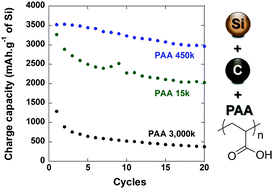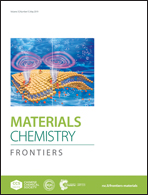Revisiting and improving the preparation of silicon-based electrodes for lithium-ion batteries: ball milling impact on poly(acrylic acid) polymer binders†
Abstract
This study revisits and optimizes silicon/carbon/poly(acrylic acid) – (PAA) composite anode preparation for lithium-ion batteries. The objective is to analyze the specific impact of the high energy ball milling step on the PAA polymer binder and on the composite anode electrochemical behavior in order to improve cycling performance. For this purpose, three commercial PAAs with 15, 450 and 3000 kg mol−1 average molar masses are considered. PAA structural alterations induced by ball milling are investigated by SEC, IRTF, 1H NMR and TGA. It appears that PAA 15k is slightly degraded while higher molar mass PAAs are significantly deteriorated. An innovative optimized formulation, combining (1) ball milling of carbon and Si only followed by (2) magnetic stirring of this mixture with PAA and a dispersant is proposed and compared to an all ball milling formulation. The first step is essential to get good electrochemical performance and the second enables the maintenance of polymer integrity. The highest electrochemical capacity retention after 20 cycles is obtained for the PAA 450k-based electrode (84%) compared with those of PAA 15k and PAA 3000k of 62% and 29%, respectively. Interestingly, this capacity retention is also significantly improved compared with that of the corresponding PAA 450k all ball milling formulation electrode (65%).



 Please wait while we load your content...
Please wait while we load your content...